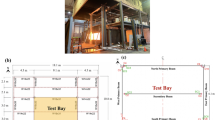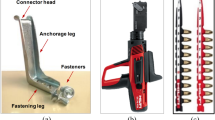Abstract
Shear tab connections are one of the most commonly used simple beam-end framing connections. Simple connections are designed to resist shear forces at ambient temperature. This study aims at identifying the key parameters that affect the behavior of composite beams with shear tab connections under fire. Large axial forces are generated during a fire event due to the thermal expansion of the materials. These forces, which are not considered in the design, could lead to connection failure. In this study, finite element (FE) models are developed in Abaqus and validated against experimental data available in the literature. The strength degradation of the steel material at elevated temperatures is accounted for using retention factors. Concrete damage plasticity is implemented to model the concrete behavior at high temperatures. FE simulations are then performed to investigate the effect of different parameters on the behavior of shear tab connections in composite beams subjected to fire. The main parameters are: load ratio, concrete slab temperature, shear tab thickness, setback distance, bolt diameter, in addition to the creep in the concrete and the partial composite action. This proposed research provides more guidance on the effect of thermally induced forces and deformations of shear tab connections with composite beams. It also provides the basis for developing simple methods of analysis.









Similar content being viewed by others
References
Agarwal, A., Selden, K., & Varma, A. (2014). Stability behavior of steel building structures in fire conditions: Role of composite floor system with shear-tab connections. Journal of Structural Fire Engineering,5, 77–96.
Allam, A., Burgess, I., & Plank, R. (2002), Performance-based simplified model for a steel beam at large deflection in fire. In 4th international conference on performance-based codes and fire safety design methods.
American Institute of Steel Construction (AISC). (2010). Specification for structural steel buildings. Chicago: ANSI/AISC360-10.
American Welding Society (AWS). (2010). Structural welding code-steel. Miami: AWS D1.1/D1.1M:2010.
Burgess, I., Davison, J., Dong, G., & Huang, S. (2012). The role of connections in the response of steel frames to fire. Structural Engineering International,22, 449–461.
Commission, E. (1997). Fire resistance of composite slabs with profiled steel sheet and of composite steel concrete beams Part 2: Composite beams. Luxembourg: EUR 16822.
European Committee for Standardization (CEN). (1995). Eurocode 2: Design of concrete structures. Part 1–2: General rules—Structural fire design. Brussels: DD ENV 1992-1-2.
European Committee for Standardization (CEN). (2004). Eurocode 2: Design of concrete structures. Part 1–2: General rules—structural fire design. Brussels: BS EN 1992-1-2.
European Committee for Standardization (CEN). (2005a). Eurocode 3: Design of steel structures. Part 1–2: General rules—Structural fire design. Brussels: BS EN 1993-1-2.
European Committee for Standardization (CEN). (2005b). Eurocode 4: Design of composite steel and concrete structures. Part 1–2: General rules structural fire design. Brussels: BS EN 1994-1-2.
Fischer, E. C., & Varma, A. H. (2015). Fire behavior of composite beams with simple connections: Benchmarking of numerical models. Journal of Constructional Steel Research,111, 112–125.
Fischer, E. C., & Varma, A. H. (2017). Fire resilience of composite beams with simple connections: Parametric studies and design. Journal of Constructional Steel Research,128, 119–135.
Garlock, M. E., & Selamet, S. (2010). Modeling and behavior of steel plate connections subject to various fire scenarios. Journal of Structural Engineering,136, 897–906.
Gernay, T., & Franssen, J.-M. (2012). A formulation of the Eurocode 2 concrete model at elevated temperature that includes an explicit term for transient creep. Fire Safety Journal,51, 1–9.
Hosseini, S., Zeinoddini, M., & Darian, A. (2014). Modelling of I-shaped beam-to-tubular column connection subjected to post-fire conditions. International Journal of Steel Structures,14, 513–528.
Hu, G., Morovat, M. A., Lee, J., Schell, E., Engelhardt, M. D. (2009). Elevated temperature properties of ASTM A992 steel. In Structures congress (pp. 1067–1076).
Lee, J., & Fenves, G. L. (1998). Plastic-damage model for cyclic loading of concrete structures. Journal of Engineering Mechanics,124, 892–900.
Morovat, A., El Ghor, A., & Hantouche, E. (2018). Time-dependent response of flush endplate connections to fire temperatures. Journal of Structural Engineering,144, 04018023.
Pakala, P., & Kodur, V. (2016). Effect of concrete slab on the behavior of fire exposed subframe assemblies with bolted double angle connections. Engineering Structures,107, 101–115.
Qiang, X., Wu, N., Luo, Y., Jiang, X., & Bijlaard, F. (2018). Experimental and theoretical study on high strength steel extended endplate connections after fire. International Journal of Steel Structures,18, 609–634.
Selden, K. L., Fischer, E. C., Varma, A. H. (2014). Advanced fire testing of a composite beam with shear tab connections. In Structurescongress (pp. 1170–1174).
Selden, K. L., Fischer, E. C., & Varma, A. H. (2016). Experimental investigation of composite beams with shear connections subjected to fire loading. Journal of Structural Engineering,142, 1–12.
Steel Construction Institute (SCI). (2006). Fire safe design: A new approach to multi-storey steel-framed buildings. Berkshire: SCI Publication P288.
Tarantino, A. M., & Dezi, L. (1992). Creep effects in composite beams with flexible shear connectors. Journal of Structural Engineering,118, 2063–2080.
Wald, F., Simões da Silva, L., Moore, D. B., Lennon, T., Chladna, M., Santiago, A., et al. (2006). Experimental behaviour of a steel structure under natural fire. Fire Safety Journal,41, 509–522.
Wang, W., Huang, G.-S., Li, G.-Q., & Engelhardt, M. D. (2016a). Behavior of steel-concrete partially composite beams subjected to fire-part 1: Experimental study. Fire Technology,53, 1039–1058.
Wang, W., Wang, K., Li, G., & Engelhardt, M. D. (2016b). Behavior of steel-concrete partially composite beams subjected to fire-part 2: Analytical study. Fire Technology,53, 1147–1170.
Wang, Y. C., & Yin, Y. Z. (2006). A simplified analysis of catenary action in steel beams in fire and implications on fire resistant design. Steel and Composite Structures,6, 367–386.
Yu, H., Burgess, I., Davison, J., & Plank, R. (2009). Experimental investigation of the behavior of fin plate connections in fire. Fire Technology,65, 723–736.
Author information
Authors and Affiliations
Corresponding author
Additional information
Publisher's Note
Springer Nature remains neutral with regard to jurisdictional claims in published maps and institutional affiliations.
Rights and permissions
About this article
Cite this article
Hajjar, M.A., Hantouche, E.G. Predicting the Demand of Shear Tab Connections with Composite Beams in Fire. Int J Steel Struct 20, 817–832 (2020). https://doi.org/10.1007/s13296-020-00325-5
Received:
Accepted:
Published:
Issue Date:
DOI: https://doi.org/10.1007/s13296-020-00325-5




